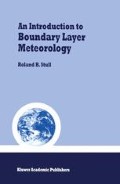Abstract
Turbulence kinetic energy (TKE) is one of the most important variables in micrometeorology, because it is a measure of the intensity of turbulence. It is directly related to the momentum, heat, and moisture transport through the boundary layer. Turbulence kinetic energy is also sometimes used as a starting point for approximations of turbulent diffusion.
Access this chapter
Tax calculation will be finalised at checkout
Purchases are for personal use only
Preview
Unable to display preview. Download preview PDF.
References
André, J.-C., G. De Moor, P. Lacarrère, G. Therry, and R. du Vachat, 1978: Modeling the 24-hour evolution of the mean and turbulent structures of the planetary boundary layer. Atmos. Sci., 35, 1861–1883.
Businger, J.A., J.C. Wyngaard, Y. Izumi and E.F. Bradley, 1971: Flux profile relationships in the atmospheric surface layer. J. Atmos. Sci., 28, 181–189.
Caughey, S.J., J.C. Wyngaard and J.C. Kaimal, 1979: Turbulence in the evolving stable boundary layer. J. Atmos. Sci., 36, 1041–1052.
Chou, S.-H., D. Atlas, and E.-N. Yeh, 1986: Turbulence in a convective marine atmospheric boundary layer. J. Atmos. Sci., 43, 547–564.
Deardorff, J.W., 1974: Three-dimensional numerical study of turbulence in an entraining mixed layer. Bound.-Layer Meteor., 7, 199–226.
Gal-Chen, T. and R.A. Kropfli, 1984: Buoyancy and pressure perturbations derived from dual-Doppler radar observations of the planetary boundary layer: applications for matching models with observations. J. Atmos. Sci., 41, 3007–3020.
Hechtel, L.M., 1988: The effects of nonhomogeneous surface heat and moisture fluxes on the convective boundary layer. Preprints of the Am. Meteor. Soc. 8th Symposium on Turbulence and Diffusion in San Diego, April 1988. 4pp.
Holtslag, A.A.M. and F.T.M. Nieuwstadt, 1986: Scaling the atmospheric boundary layer. Bound.-Layer Meteor., 36, 201–209.
Kitchen, M., J.R. Leighton and S.J. Caughey, 1983: Three case studies of shallow convection using a tethered balloon. Bound.-Layer Meteor., 27, 281–308.
Lee, D.R., R. B. Stull, and W.S. Irvine, 1979: Clear Air Turbulence Forecasting Techniques. AFGWC/TN-79/001. Air Force Global Weather Central, Offutt AFB, NE 68113. 73pp.
Lenschow, D.H., 1974: Model of the height variation of the turbulence kinetic energy budget in the unstable planetary boundary layer.J. Atmos. Sci., 31, 465–474.
Lenschow, D.H., J.C. Wyngaard and W.T Pennell, 1980: Mean field and second moment budgets in a baroclinic, convective boundary layer. J. Atmos. Sci., 37, 1313–1326.
Louis, J.F., A. Weill and D. Vidal-Madjar, 1983: Dissipation length in stable layers. Bound.-Layer Meteor., 25, 229–243.
Mahrt, L., 1981: Modelling the depth of the stable boundary layer. Bound.-Layer Meteor., 21, 3–19.
McBean, G.A. and J.A. Elliott, 1975: The vertical transports of kinetic energy by turbulence and pressure in the boundary layer. J Atmos. Sci., 32, 753–766.
Nicholls, S., M.A. Lone and G. Sommeria, 1982: The simulation of a fair weather marine boundary layer in GATE using a three dimensional model. Quart. J. Roy. Meteor. Soc., 108, 167–190.
Nicholls, S. and C.J. Readings, 1979: Aircraft observations of the structure of the lower boundary layer over the sea. Quart. J. Roy. Meteor. Soc. 105, 785–802.
Noonkester, V.R., 1974: Convective activity observed by FM-CW radar. Naval Electronics Lab. Center, NELQTR 1919. San Diego, CA 92152. 70pp.
Pennell, W.T. and M.A. Lone, 1974: An experimental study of turbulence structure in the fair-weather trade wind boundary layer. J. Atmos. Sci., 31, 1308–1323.
Stage, S.A. and J.A. Businger, 1981: A model for entrainment into a cloud-topped marine boundary layer. Part I. Model description and application to a cold air outbreak episode. J. Atmos. Sci. 38, 2213–2229.
Therry, G. and P. Lacarrètre, 1983: Improving the eddy kinetic energy model for planetary boundary layer description. Bound.-Layer Meteor., 25, 63–88.
Thorpe, S.A., 1969: Experiments on the stability of stratified shear flows. Radio Science, 4, 1327–1331.
Thorpe, S.A., 1973: CAT in the lab. Weather, 28, 471–475.
Wilczak, J.M. and J.A. Businger, 1984: Large-scale eddies in the unstably stratified atmospheric surface layer. Part II. Turbulent pressure fluctuations and the budgets of heat flux, stress and turbulent kinetic energy. J. Atmos. Sri., 41, 3551–3567.
Woods, J.D., 1969: On Richardson’s number as a criterion for laminar-turbulent-laminar transition in the ocean and atmosphere.Radio Science 4,1289–1298.
Wyngaard, J.C., 1973: On surface layer turbulence. Workshop on Micrometeorology, D.A. Haugen (Ed.), Amer. Meteor. Soc., Boston. 101–149.
Yamada, T. and G. Mellor, 1975: A simulation of the Wangara atmospheric boundary layer data. J. Atmos. Sci., 32, 2309–2329.
Zhou, M.Y., D.H. Lenschow, B.B. Stankov, J.C. Kaimal, and J.E. Gaynor, 1985: Wave and turbulence structure in a shallow baroclinic convective boundary layer and overlying inversion. J. Atmos. Sci., 42, 47–57.
Author information
Authors and Affiliations
Editor information
Editors and Affiliations
Rights and permissions
Copyright information
© 1988 Kluwer Academic Publishers
About this chapter
Cite this chapter
Stull, R.B. (1988). Turbulence Kinetic Energy, Stability and Scaling. In: Stull, R.B. (eds) An Introduction to Boundary Layer Meteorology. Atmospheric Sciences Library, vol 13. Springer, Dordrecht. https://doi.org/10.1007/978-94-009-3027-8_5
Download citation
DOI: https://doi.org/10.1007/978-94-009-3027-8_5
Publisher Name: Springer, Dordrecht
Print ISBN: 978-90-277-2769-5
Online ISBN: 978-94-009-3027-8
eBook Packages: Springer Book Archive

